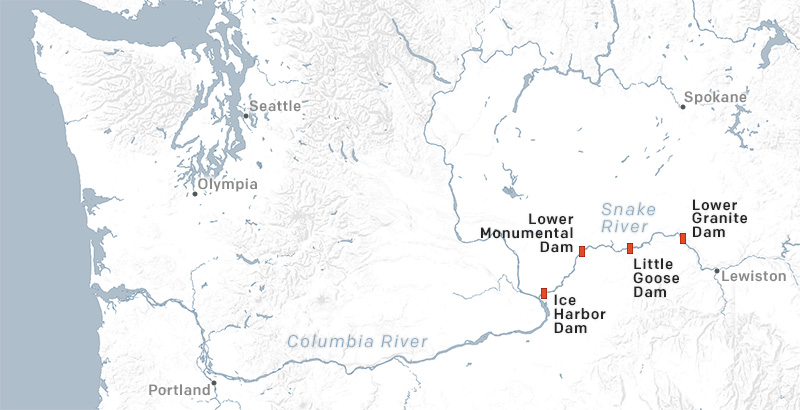Today in the Sixth Extinction

Ever since the giant dams on the Columbia and Snake Rivers were constructed in the mid-20th century, people have known that they destroy salmon runs. The 4 huge dams on the lower Snake are particularly awful and unnecessary. But because the people in Lewiston are really proud of their stupid worthless port and because for many, many people, dams equal progress and thus the hippies who want to tear them down obviously want to take us back to prehistoric times, the salmon are about to go extinct.
Some 45,000 to 50,000 spring-summer Chinook spawned here in the 1950s. These days, the average is about 1,500 fish, and declining. And not just here: Native fish are in free-fall throughout the Columbia River basin, a situation so dire that many groups are urging the removal of four large dams to keep the fish from being lost.
“The Columbia River was once the most productive wild Chinook habitat in the world,” said Russ Thurow, a fisheries research scientist with the Forest Service’s Rocky Mountain Research Station.
Standing alongside the Salmon River in Idaho, Mr. Thurow considered the prospect that the fish he had spent most of his life studying could disappear. “It’s hard to say, but now these fish have maybe four generations left before they are gone,” he said. “Maybe 20 years.”
Thirteen species of salmon and steelhead trout are listed as threatened or endangered in the Columbia basin, an area that includes parts of Idaho, Oregon, Washington, Montana and British Columbia. Salmon are a keystone species in this region, critical as a food source for animals from bears to eagles to insects.
That group of beneficiaries includes an endangered population of orcas, or killer whales, along the West Coast that survive by eating Chinook in the winter and spring, up to 30 a day.
Many experts believe the orcas are starving in large part because of the decline of wild salmon. This year alone, their number has dropped from 76 to 73, alarming conservationists and scientists. Last year, an orca mother carried a dead calf for 17 days on her back. She was presumed to be grieving.
“The best thing you could do to get more spring Chinook for the orcas is to remove those four lower dams,” said Don Chapman, a retired fisheries scientist who worked as a consultant to the hydropower industry and defended the dams and mitigation efforts.
He has since changed his mind about the dams: “They kill too many juveniles going downstream and some adults going back.”
Salmon are swimming in warming waters, with uncertain consequences, according to a recent study. Breaching the dams also would help keep water temperatures cooler as the climate changes, Dr. Chapman said.
Like so many of our environmental problems, fixing this is eminently doable. But, you know, hippies. So despite salmon being central to the Northwest’s regional identity, they are doomed.


